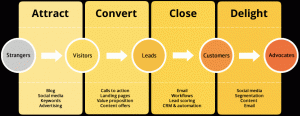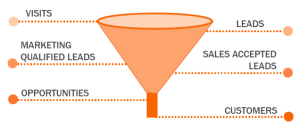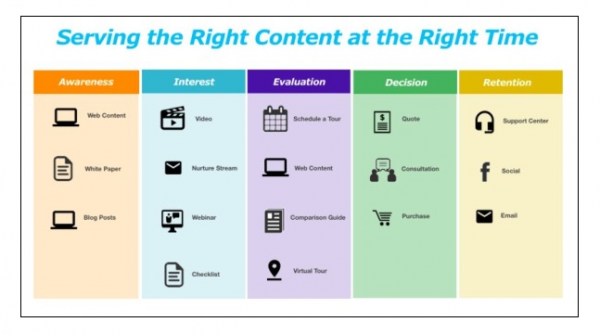
B2B Articles - March 08, 2017
Phrases such as “buyer’s journey” and “customer lifecycle” are recurring buzzwords in marketing today. Yet how many marketers know how to clearly define buyer lifecycle stages?
According to B2B Marketing Research, 68% of marketers have not defined their funnel.
Defining lifecycle stages brings a huge advantage to your marketing strategy. It helps you understand and manage your contacts' intent, then plan content around specific concerns. This means more leads moving through the funnel.

And if you can break from the majority of marketers by defining your funnel, you will have a clear advantage. You will align your marketing and sales teams, create more compelling content, and drive relevancy for your leads.
Here is an overview of how to define your own buyer lifecycle stages.
Before diving in to define buyer lifecycle stages, we'll recap the definition of the "buyer lifecycle."
The buyer lifecycle represents the progression of a customer through the buying process. This progression may (or may not) be linear. A lead often enters the lifecycle while they are still considering needs — usually long before they contact a salesperson.
“Both Gartner and Forrester predict that by 2020, more than 80% of the buying process will occur without any direct human-to-human interaction.” — Aberdeen
Clear lifecycle stages teach marketers how to understand their leads in context.
As a result, they can plan smarter campaigns. Additionally, they grow relationships with leads long before making the sale.
https://www.ironpaper.com/articles/defining-the-b2b-marketing-to-sales-lifecycle/
As you define your lifecycle stages, start by understanding the common tactics to avoid:
For example, are sales-qualified leads actually responsive to a sales call? If not, your definition might not be accurate. You could consider changing the definition so leads have more time to engage more fully with education before receiving a sales call.
First, you'll need to determine the lifecycle model that your company will use. There are several different iterations of the buyer's stages.
For example, VisionEdge Marketing breaks the lifecycle into 6 C’s:
 The perhaps more widely used definition by HubSpot includes:
The perhaps more widely used definition by HubSpot includes:
Pick a model that works for your business and sales cycle.
Just make sure that whichever model you choose, you clearly communicate the stages with your sales team and with other marketers working on contact management. Buyer lifecycle stages should become a very standardized practice at your company.
Simply choosing a lifecycle model is not sufficient. You must understand the behaviors that indicate which stage someone falls into, and create a system to label leads by stage.
For example, if someone downloads an eBook, does that make them marketing-qualified? How do you label them as an MQL in your database? What is the corresponding action that happens afterwards? What is the "next step" for them to take?
 Image source: Hubspot
Image source: Hubspot
Here are the questions your company must ask (and answer!) to guide leads through these stages:
https://www.ironpaper.com/articles/how-to-match-content-to-buyers-journey-stage/
Ideally, the sales team will give their insight and help define buyer lifecycle stages.
This is because when you align your sales and marketing team's expertise, you create definitions with greater depth and actionability.
Organizations that formally map and manage buyer journeys experience a 79% higher annual increase in cross-sell and up-sell revenue, on average. — Aberdeen
Marketing automation software has data that is invaluable to marketers. This data can help teams determine how customers engage, drop off, and move through the funnel — and, of course, set lifecycle stages accordingly.
https://www.ironpaper.com/articles/benefits-marketing-automation/
For example, with a CRM like HubSpot, you can see historical data on individual contacts. By working backwards, you can find earlier actions that indicated sales readiness.
Such data can help to analyze content efficacy, workflow conversion rates, customer engagement, and more.
And, most importantly, data will help you tweak your lifecycle stages and refine your sales funnel plan.
Even with GPS technology today, we can find ourselves in fairly built-up areas hearing the car announce, "Entering an unmapped area." Expect the same kinds of seemingly inexplicable detours from the buyer journey.
Pay attention to associated trends to identify how well contacts are moving through the funnel, or find places to tighten the lifecycle flow for better success.
Sources
Aberdeen Essentials. (2015, March 3). Creating Content is a Waste of Time – Until You’ve Mapped the Buyer Journey [Part 1: Define The Buying Journey]. https://www.aberdeenessentials.com/cmo-essentials/creating-content-waste-time-youve-mapped-buyer-journey-part-1-define-buying-journey/
HubSpot. (n.d.). Why lifecycle marketing is important. https://academy.hubspot.com/emc16/sending-the-right-message-with-lifecycle-marketing
B2B Marketing Research. (2012, March). 2B Marketing Research: 68% of B2B marketers haven’t identified their Marketing-Sales funnel … and it shows. https://sherpablog.marketingsherpa.com/b2b-marketing/b2b-marketing-sales-funnel-missing/
Tel 212-993-7809
Ironpaper ®
10 East 33rd Street
6th Floor
New York, NY 10016
Map
First-party data marketing
SEO for B2B
Customer journey strategy
ABM Agency
Marketing for IoT Companies
HubSpot Implementation
B2B Product Marketing
Measurable Marketing
IoT go-to-market strategy
IT Marketing
HubSpot for ABM
Go to market strategy
Technology Marketing
Marketing for IT Companies
ABM Campaigns
B2B lead generation
B2B Marketing and Growth Agency.
Grow your B2B business boldly. Ironpaper is a B2B marketing agency. We build growth engines for marketing and sales success. We power demand generation campaigns, ABM programs, create B2B content, strengthen sales enablement, generate qualified leads, and improve B2B marketing efforts.